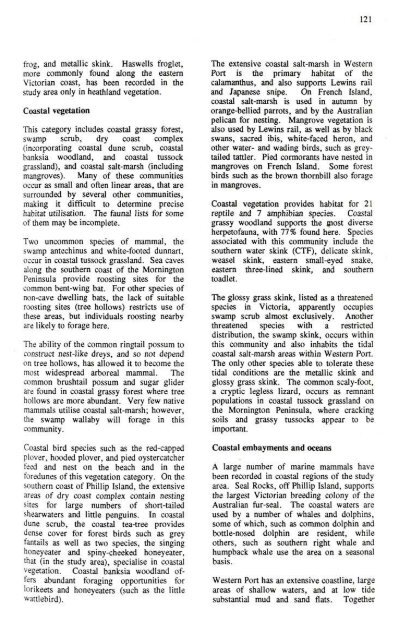Factors Affecting Flora Conservation - Victorian Environmental ...
Factors Affecting Flora Conservation - Victorian Environmental ...
Factors Affecting Flora Conservation - Victorian Environmental ...
Create successful ePaper yourself
Turn your PDF publications into a flip-book with our unique Google optimized e-Paper software.
121<br />
frog, and metallic skink. Haswells froglet,<br />
more commonly found along the eastem<br />
<strong>Victorian</strong> coast, has been recorded in the<br />
study area only in heathland vegetation.<br />
Coastal vegetation<br />
This category includes coastal grassy forest,<br />
swamp scmb, dry coast complex<br />
(incorporating coastal dune scmb, coastal<br />
banksia woodland, and coastal tussock<br />
grassland), and coastal salt-marsh (including<br />
mangroves). Many of these communities<br />
occur as small and often linear areas, that are<br />
surrounded by several other communities,<br />
making it difficult to determine precise<br />
habitat utilisation. The faunal fists for some<br />
of diem may be incomplete.<br />
Two uncommon species of mammal, the<br />
swamp antechinus and white-footed dunnart,<br />
occur in coastal tussock grassland. Sea caves<br />
along the southern coast of the Mornington<br />
Peninsula provide roosting sites for the<br />
common bent-wing bat. For other species of<br />
non-cave dwelling bats, the lack of suitable<br />
roosting sites (free hollows) restricts use of<br />
these areas, bul individuals roosting nearby<br />
are likely to forage here.<br />
The ability of the common ringtail possum to<br />
constmct nest-like dreys, and so not depend<br />
on tree hollows, has allowed it to become the<br />
most widespread arboreal mammal. The<br />
common bmshtail possum and sugar glider<br />
are found in coastal grassy forest where tree<br />
hollows are more abundant. Very few native<br />
mammals utilise coastal salt-marsh; however,<br />
the swamp wallaby wUl forage in this<br />
community.<br />
Coastal bird species such as the red-capped<br />
plover, hooded plover, and pied oystercatcher<br />
feed and nest on die beach and in die<br />
foredunes of this vegetation category. On die<br />
southern coast of PhUlip Island, die extensive<br />
areas of dry coast complex contain nesting<br />
sites for large numbers of short-tailed<br />
shearwaters and little penguins. In coastal<br />
dune scmb, the coastal tea-tree provides<br />
dense cover for forest birds such as grey<br />
fantalls as well as two species, the singing<br />
honeyeater and spiny-cheeked honeyeater,<br />
that (in the study area), specialise in coastal<br />
vegetation. Coastal banksia woodland offers<br />
abundant foraging opportunities for<br />
lorikeets and honeyeaters (such as the little<br />
watflebird).<br />
The extensive coastal salt-marsh in Western<br />
Port is the primary habitat of the<br />
calamanthus, and also supports Lewins rail<br />
and Japanese snipe. On French Island,<br />
coastal salt-marsh is used in autumn by<br />
orange-bellied parrots, and by the Australian<br />
pelican for nesting. Mangrove vegetation is<br />
also used by Lewins raU, as well as by black<br />
swans, sacred ibis, white-faced heron, and<br />
other water- and wading birds, such as greytailed<br />
tattler. Pied cormorants have nested in<br />
mangroves on French Island. Some forest<br />
birds such as the brown thornbUl also forage<br />
in mangroves.<br />
Coastal vegetation provides habitat for 21<br />
reptile and 7 amphibian species. Coasta)<br />
grassy woodland supports the most diverse<br />
herpetofauna, with 77% found here. Species<br />
associated with this community include die<br />
southern water skink (CTF), delicate skink,<br />
weasel skink, eastem small-eyed snake,<br />
eastern three-lined skink, and southern<br />
toadlet.<br />
The glossy grass skink, listed as a threatened<br />
species in Victoria, apparenfly occupies<br />
swamp scmb almost exclusively. Another<br />
threatened species with a restricted<br />
distribution, the swamp skink, occurs wiihin<br />
this community and also inhabits the tidal<br />
coastal salt-marsh areas within Westem Port.<br />
The only other species able to tolerate these<br />
tidal conditions are the metallic skink and<br />
glossy grass skink. The common scaly-foot,<br />
a cryptic legless lizard, occurs as remnant<br />
populafions in coastal tussock grassland on<br />
the Momington Peninsula, where cracking<br />
soils and grassy tussocks appear to be<br />
important.<br />
Coastal embayments and oceans<br />
A large number of marine mammals have<br />
been recorded in coastal regions of the study<br />
area. Seal Rocks, off' Phillip Island, supports<br />
the largest <strong>Victorian</strong> breeding colony of the<br />
Australian fur-seal. The coastal waters are<br />
used by a number of whales and dolphins,<br />
some of which, such as common dolphin and<br />
bottle-nosed dolphin are resident, while<br />
others, such as southern right whale and<br />
humpback whale use the area on a seasonal<br />
basis.<br />
Westem Port has an extensive coasfline, large<br />
areas of shallow waters, and at low tide<br />
substantial mud and sand flats. Together
















